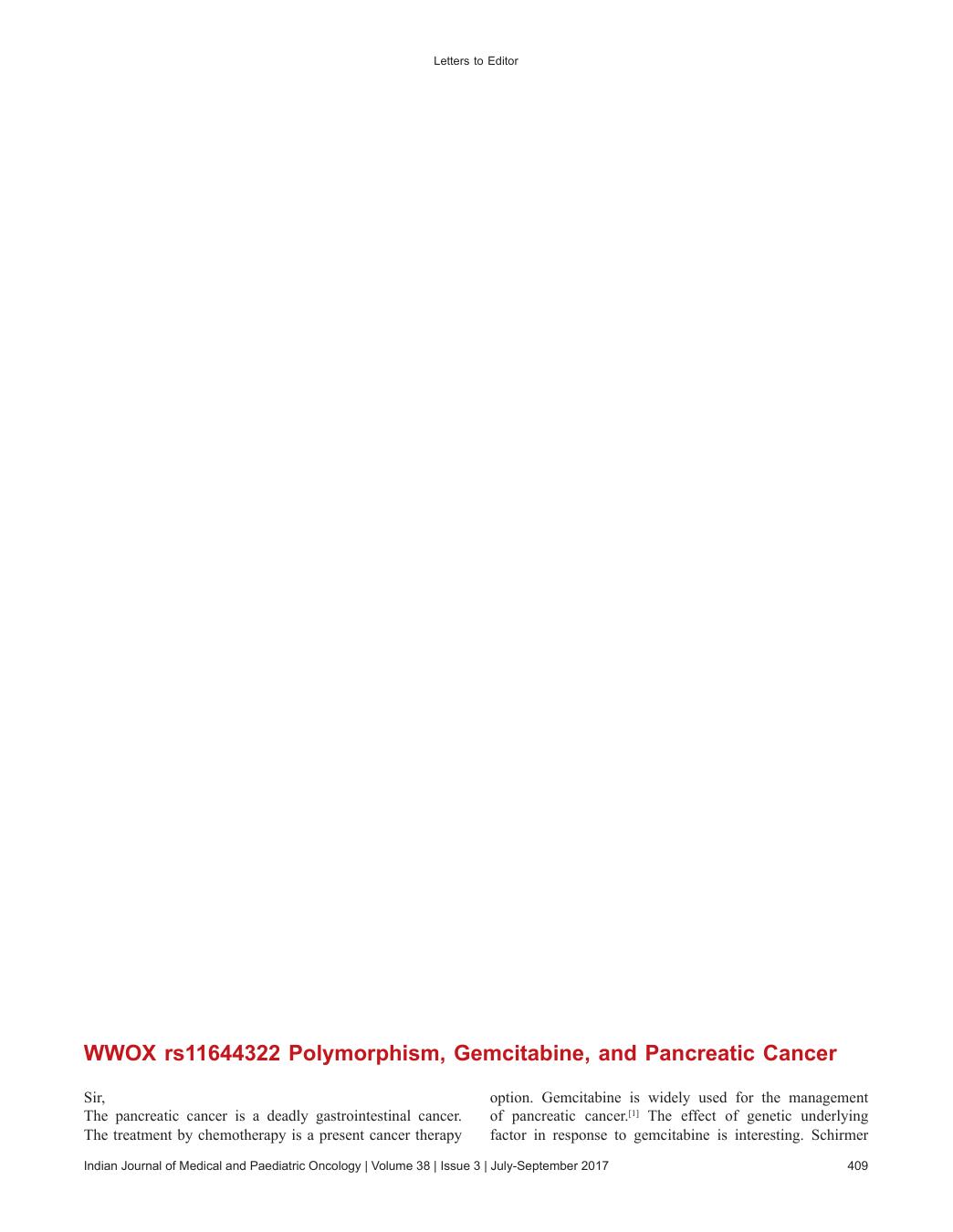WWOX rs11644322 Polymorphism, Gemcitabine, and Pancreatic Cancer
CC BY-NC-ND 4.0 · Indian J Med Paediatr Oncol 2017; 38(03): 409-410
DOI: DOI: 10.4103/ijmpo.ijmpo_125_17

|
Publication History
Article published online:
04 July 2021
© 2017. Indian Society of Medical and Paediatric Oncology. This is an open access article published by Thieme under the terms of the Creative Commons Attribution-NonDerivative-NonCommercial-License, permitting copying and reproduction so long as the original work is given appropriate credit. Contents may not be used for commercial purposes, or adapted, remixed, transformed or built upon. (https://creativecommons.org/licenses/by-nc-nd/4.0/.)
Thieme Medical and Scientific Publishers Pvt. Ltd.
A-12, 2nd Floor, Sector 2, Noida-201301 UP, India
Sir,
The pancreatic cancer is a deadly gastrointestinal cancer. The treatment by chemotherapy is a present cancer therapy option. Gemcitabine is widely used for the management of pancreatic cancer.[1] The effect of genetic underlying factor in response to gemcitabine is interesting. Schirmer et al. reported that “WWOX rs11644322 represents a major predictive factor in gemcitabine-treated pancreatic cancer. Decreased WWOX expression may interfere with gemcitabine sensitivity.”[2] Schirmer et al. found that the survival period of the patients decreased in order if they present GG, GA, and AA genotypes, respectively.[2] Here, the authors would like to discuss on the finding based on the quantum medicine calculation as previously reported in referenced publications.[3,4,5]
Theoretically, the three genotypes can be successfully expressed, but there will be the difference in degree of expression based on the starting molecular component. In translation, the final amount of product will vary on the variation on molecular weight of genetic component. From calculation, the molecular weight will be N + 302.26, N + 286.26, and N + 270.28, where N is the molecular weight of other nucleotides apart from the variant point, for GG, GA, and AA genotypes, respectively. It can be seen that the variation AA has the lowest amount of starting molecular component; hence, it might result in the lowest amount of final product which further implies the lowest amount of successful bringing of derived translated product and drug, gemcitabine.
Financial support and sponsorshipNil.
Conflicts of interest
There are no conflicts of interest.
References
- Weinberg BA, Philip PA, Salem ME. Evolving standards of care for resected pancreatic cancer. Clin Adv Hematol Oncol 2017;15:141-50.
- Schirmer MA, Lüske CM, Roppel S, Schaudinn A, Zimmer C, Pflüger R, et al. Relevance of Sp binding site polymorphism in WWOX for treatment outcome in pancreatic cancer. J Natl Cancer Inst 2016;108:5.
- Joob B, Wiwanitkit V. HSD11B1 rs846908 polymorphisms and tacrolimus concentrations: Quantum chemical analysis and implication in patients with renal transplantation. J Nephropharmacol 2016;6:19-20.
- Joob B, Wiwanitkit V. ATP-binding cassette, sub-family B (MDR/TAP), member 1 (ABCB1) polymorphism and clopidogrel concentration in acute coronary syndrome: Molecular change can explain the observed therapeutic concentration. Anatol J Cardiol 2016;16:303-4.
- Wiwanitkit S, Wiwanitkit V. Change in molecular weight due to important pfatp6 and pfmdr1 polymorphisms and susceptibility to antimalarial drug: Possible role of epigenetic phenomenon. Asian Pac J Trop Biomed 2017;7:181-2.
References
- Weinberg BA, Philip PA, Salem ME. Evolving standards of care for resected pancreatic cancer. Clin Adv Hematol Oncol 2017;15:141-50.
- Schirmer MA, Lüske CM, Roppel S, Schaudinn A, Zimmer C, Pflüger R, et al. Relevance of Sp binding site polymorphism in WWOX for treatment outcome in pancreatic cancer. J Natl Cancer Inst 2016;108:5.
- Joob B, Wiwanitkit V. HSD11B1 rs846908 polymorphisms and tacrolimus concentrations: Quantum chemical analysis and implication in patients with renal transplantation. J Nephropharmacol 2016;6:19-20.
- Joob B, Wiwanitkit V. ATP-binding cassette, sub-family B (MDR/TAP), member 1 (ABCB1) polymorphism and clopidogrel concentration in acute coronary syndrome: Molecular change can explain the observed therapeutic concentration. Anatol J Cardiol 2016;16:303-4.
- Wiwanitkit S, Wiwanitkit V. Change in molecular weight due to important pfatp6 and pfmdr1 polymorphisms and susceptibility to antimalarial drug: Possible role of epigenetic phenomenon. Asian Pac J Trop Biomed 2017;7:181-2.


 PDF
PDF  Views
Views  Share
Share

